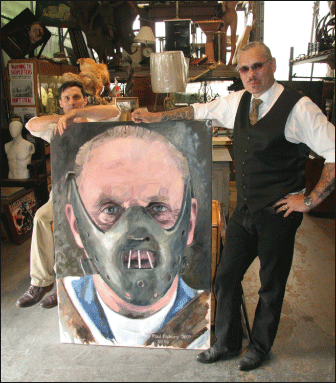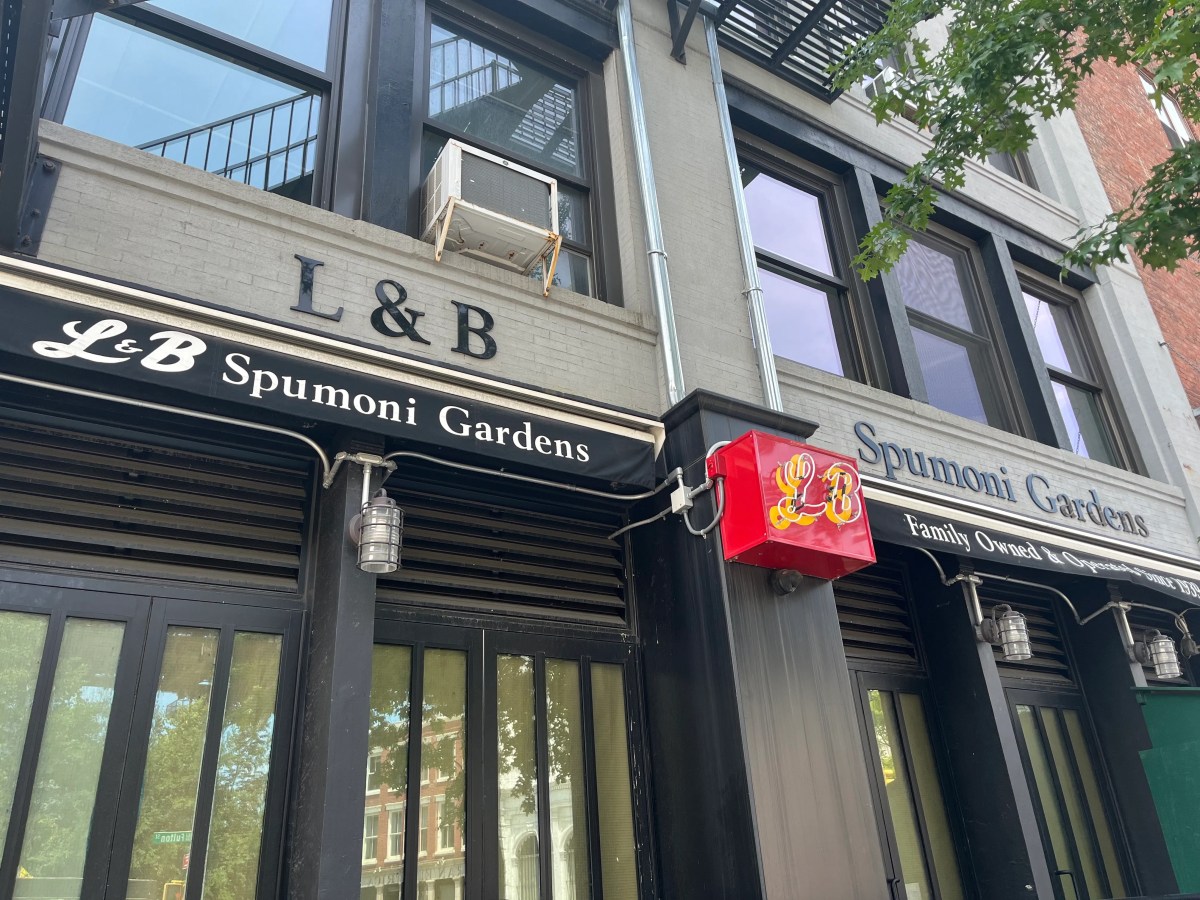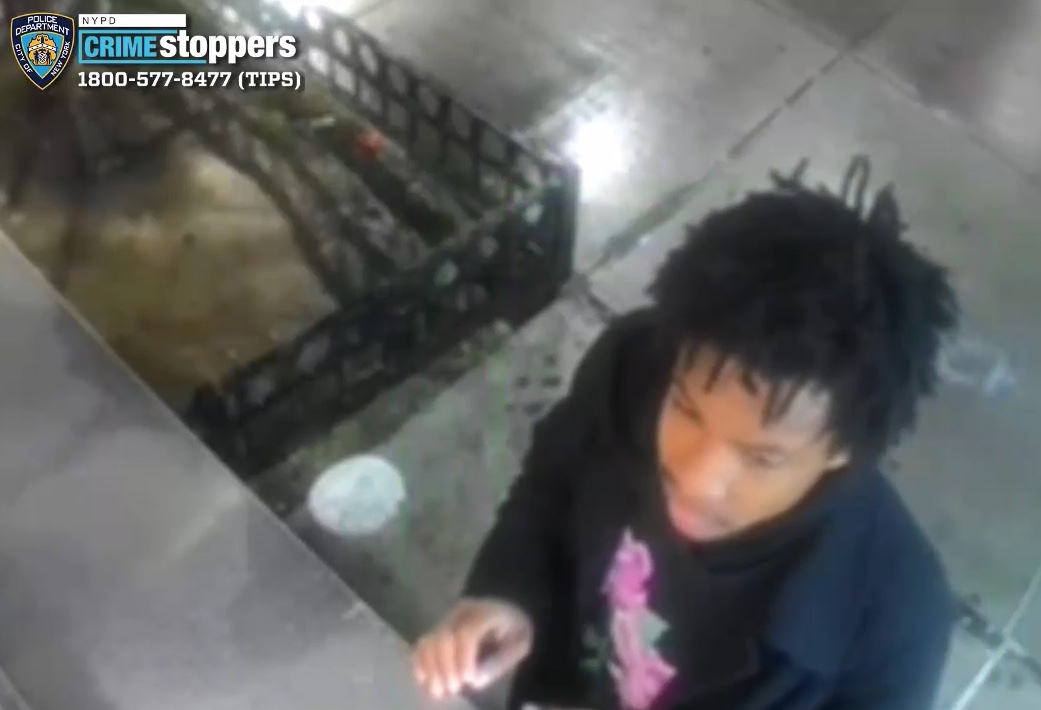By Gerry Visco
It was a typical night over at Billy’s Antiques & Props on E. Houston St. hard by the Bowery. You’ve seen the place — arrayed on the sidewalk in front of the old green tent, a collection of stylish vintage bureaus, funky coffee tables and kitschy objets d’art for sale by offbeat characters.
Enter and you’ll find the eponymous storeowner, Billy Leroy. Look for the tall dapper figure of a man with a long, light-brown ponytail, tattoos peeking out from his elegant custom-made shirt. And lurking in every corner and hanging from the ceiling of the tent are demons and gargoyles, Jesus with a bloodied crown of thorns, stuffed foxes and other fauna in a tableau of fabulously secondhand treasures from everywhere.
And who better to sell such relics than Billy Leroy, who’s on stage here every day of his life, the carnival barker and emcee of the flea market where everyone, famous and humble alike, comes by to sit on a couch, open a bureau drawer, people-watch and play with Kill-Joy, the store’s affectionate Rottweiler mascot.
The store is still a salon and social epicenter of the Lower East Side, the way things used to be before big money took over. Sure, Leroy is here to make a profit of sorts, but for him, his antique business is a labor of love and a place where he, his wife, his friends and customers can come together. CBGB may have closed, high-rise luxury co-ops are invading the area, the local American Apparel is attracting yuppies in droves. A Whole Foods mega-supermarket has opened on the other side of the street, but Billy’s is still hanging in there.
The tent’s been pitched at 76 E. Houston St. since 1986, when it was called Lot 76 and run by former owner Rob Fennick. When Fennick passed away in 2003, Leroy took over and, despite rising rents, has been able to hold his own.
“Luckily, I have a progressive landlord,” he enthused with a grin. The flophouses are gone and the infamous “bucket of blood” bars, notorious watering holes for many a down-and-out drunk, have vanished. Like dinosaurs in a time warp, a few of the remaining Bowery bums emerge from hiding, lugging stuff to sell at Billy’s. Sometimes they’ll jump into the conversation or try to help make a sale. The shop is tolerant of eccentricity and that’s what makes Billy’s different from a chain store. This ain’t no disco and, as Leroy’s Web site proclaims, it ain’t no Crate & Barrel either.
Indeed, if he likes you, Leroy might even show you his “Lion Boy.” He keeps it in an old ornate cabin, stored in a formaldehyde jar. It’s a human fetus with its head fused to its back, giving it the appearance of having a mane. It’s actually a girl.
The neighborhood spirit of the Lower East Side lives on at Billy’s, whose owner takes pleasure in doing favors. For example, Leroy was instrumental in Clayton Patterson’s upcoming art opening at Kinz, Tillou + Feigen, one of New York City’s foremost art galleries, on Sept. 10. Artist, photographer, author and Downtown personality, Patterson has an archive of more than 200,000 photographs documenting the inhabitants of the Lower East Side over the last 25 years. Leroy helped select the images for the show himself and, because he believed in the value of the work, went out and pitched the project to art galleries. Both Leroy and Patterson were thrilled when the Chelsea gallery said yes.
They’ve been friends since the late 1990s because Patterson is a regular visitor to the tent. Other well-known customers of Leroy’s include Jim Jarmusch, Anton Newcombe of the Brian Jonestown Massacre, photographer Nan Goldin, other artists, rockers, movie stars, hookers, hipsters, gangstas, playas and newly arrived investment bankers and hotshot corporate lawyers.
More than 6 feet 3 inches with a long, wiry beard, Patterson seems like a tough guy — he’s renowned for filming the Tompkins Square Park riots in 1988, which he says was responsible for his being arrested 13 times and getting several teeth knocked out by the police. The burly, longtime Lower East Side resident originally hailing from Calgary, Alberta, is one of Billy Leroy’s biggest fans and the feeling is mutual.
With connoisseur Leroy’s eye for cutting-edge art developed through years of dealing in antiques and collectibles, he urged Patterson to exhibit his work officially, in a gallery. Like many artists, Patterson had neither the talent nor desire to sell his own work to one of those slick, upscale galleries. He himself runs a storefront gallery out of his home on Essex St. called the Clayton Gallery & Outlaw Museum specializing in artists outside the mainstream — but of course nowadays outsider art has become chic. Patterson has been written about in numerous publications and is the author of two books about the Lower East Side — “Captured” and “Resistance” — and is finishing up two more volumes, one about tattoos and the other, a compendium of Jewish lore from the neighborhood.
Yet Patterson’s comprehensive and fabled collection of photographs illustrating the rich social history of the area has never been publicly exhibited. Who better to represent Patterson’s work than another renegade, the ever-debonair and charming Leroy, who hung out with the rich and famous as a youth — he grew up on E. 87th St. between Park and Madison Aves. and was educated at elite prep schools in the U.S. and Switzerland. He played football at Northeastern, but to satisfy his creative urges switched to the Art Institute in Boston and graduated in 1984. He then married and had a daughter and began working at Grey Advertising as an art director. However, he soon became bored with corporate life.
“I started dabbling in antiques,” Leroy said. “I remember my father taking me to the Paris flea market.” He started buying and selling art and antiques on the side. Things started slowly and he was only making $13,000 a year, but then business quickly started to pick up.
“I bought a painting for 2,000 and sold it for 6,” he said. “Ever since then, I’ve been an antique dealer.”
Transitioning to selling antiques, he quit his job and moved his family to Paris for a few years. When they returned to New York, he got obsessed with motorcycles and became a bit of a biker. As for his home life, “we started to do the suburb thing in Paramus,” he recalled.
As he adopted a scruffier lifestyle and started amassing tattoos, he and his wife divorced. Drinking too much and partying was fun for a while, but by the late 1990s he had a revelation that his life needed more purpose. He settled down when he took over his antiques business on E. Houston St. and married singer Lorraine Leckie.
Knowing intimately the worlds of wealth and Downtown art, Leroy had the polish and the moxie to represent Patterson’s work to the galleries Uptown and the rest is history.
On a recent Friday summer night, Patterson stopped by the tent to say hello. An oversized painting of Hannibal the Cannibal Lecter, with his characteristic rubber mouth restraint, was prominently displayed this night.
A guy in an S.U.V. with his family pulled up.
“I love that painting,” he called out. “How much is it?”
Leroy always rises to the occasion.
“I just got that, it’s fresh. Three thousand bucks.”
But the man in the van was on his way home.
“Come back tomorrow, let’s make a deal,” Leroy said.
Leroy’s wife, Lorraine, who had just played a gig at the Mercury Lounge, sat on a couch strumming a guitar. Customers came and went, buying and selling, talking and hanging out. It was the Lower East Side the way it used to be — and here at Billy’s Antiques & Props it still is.






































